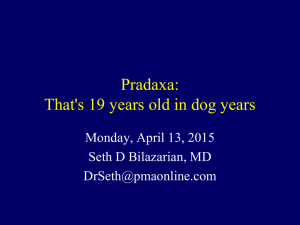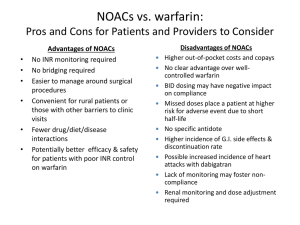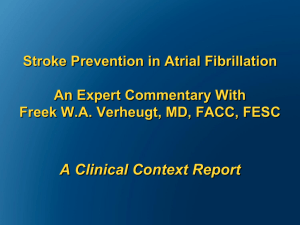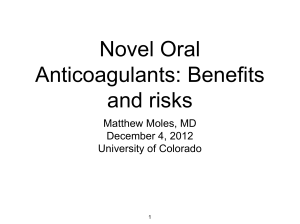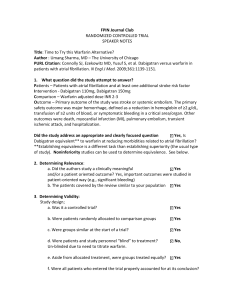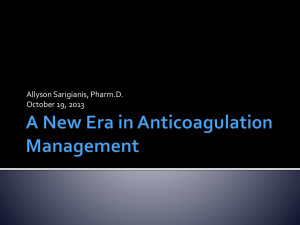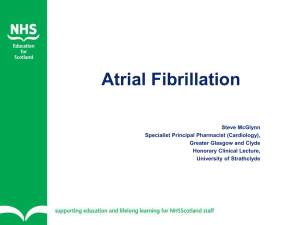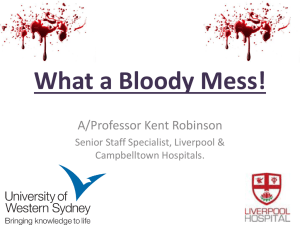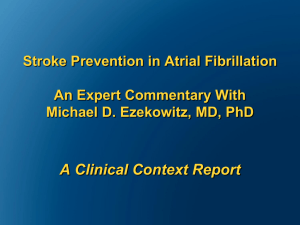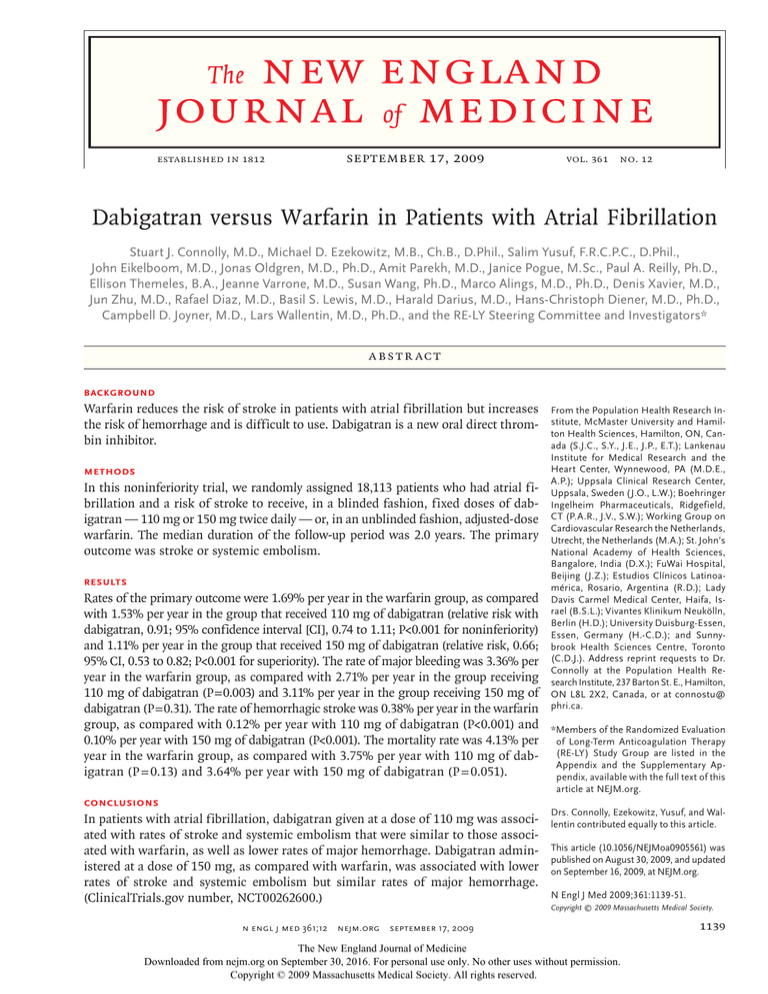
new england
journal of medicine
The
established in 1812
september 17, 2009
vol. 361 no. 12
Dabigatran versus Warfarin in Patients with Atrial Fibrillation
Stuart J. Connolly, M.D., Michael D. Ezekowitz, M.B., Ch.B., D.Phil., Salim Yusuf, F.R.C.P.C., D.Phil.,
John Eikelboom, M.D., Jonas Oldgren, M.D., Ph.D., Amit Parekh, M.D., Janice Pogue, M.Sc., Paul A. Reilly, Ph.D.,
Ellison Themeles, B.A., Jeanne Varrone, M.D., Susan Wang, Ph.D., Marco Alings, M.D., Ph.D., Denis Xavier, M.D.,
Jun Zhu, M.D., Rafael Diaz, M.D., Basil S. Lewis, M.D., Harald Darius, M.D., Hans-Christoph Diener, M.D., Ph.D.,
Campbell D. Joyner, M.D., Lars Wallentin, M.D., Ph.D., and the RE-LY Steering Committee and Investigators*
A bs t r ac t
Background
Warfarin reduces the risk of stroke in patients with atrial fibrillation but increases
the risk of hemorrhage and is difficult to use. Dabigatran is a new oral direct thrombin inhibitor.
Methods
In this noninferiority trial, we randomly assigned 18,113 patients who had atrial fibrillation and a risk of stroke to receive, in a blinded fashion, fixed doses of dabigatran — 110 mg or 150 mg twice daily — or, in an unblinded fashion, adjusted-dose
warfarin. The median duration of the follow-up period was 2.0 years. The primary
outcome was stroke or systemic embolism.
Results
Rates of the primary outcome were 1.69% per year in the warfarin group, as compared
with 1.53% per year in the group that received 110 mg of dabigatran (relative risk with
dabigatran, 0.91; 95% confidence interval [CI], 0.74 to 1.11; P<0.001 for noninferiority)
and 1.11% per year in the group that received 150 mg of dabigatran (relative risk, 0.66;
95% CI, 0.53 to 0.82; P<0.001 for superiority). The rate of major bleeding was 3.36% per
year in the warfarin group, as compared with 2.71% per year in the group receiving
110 mg of dabigatran (P = 0.003) and 3.11% per year in the group receiving 150 mg of
dabigatran (P = 0.31). The rate of hemorrhagic stroke was 0.38% per year in the warfarin
group, as compared with 0.12% per year with 110 mg of dabigatran (P<0.001) and
0.10% per year with 150 mg of dabigatran (P<0.001). The mortality rate was 4.13% per
year in the warfarin group, as compared with 3.75% per year with 110 mg of dabigatran (P = 0.13) and 3.64% per year with 150 mg of dabigatran (P = 0.051).
Conclusions
In patients with atrial fibrillation, dabigatran given at a dose of 110 mg was associated with rates of stroke and systemic embolism that were similar to those associated with warfarin, as well as lower rates of major hemorrhage. Dabigatran administered at a dose of 150 mg, as compared with warfarin, was associated with lower
rates of stroke and systemic embolism but similar rates of major hemorrhage.
(ClinicalTrials.gov number, NCT00262600.)
From the Population Health Research Institute, McMaster University and Hamilton Health Sciences, Hamilton, ON, Canada (S.J.C., S.Y., J.E., J.P., E.T.); Lankenau
Institute for Medical Research and the
Heart Center, Wynnewood, PA (M.D.E.,
A.P.); Uppsala Clinical Research Center,
Uppsala, Sweden (J.O., L.W.); Boehringer
Ingelheim Pharmaceuticals, Ridgefield,
CT (P.A.R., J.V., S.W.); Working Group on
Cardiovascular Research the Netherlands,
Utrecht, the Netherlands (M.A.); St. John’s
National Academy of Health Sciences,
Bangalore, India (D.X.); FuWai Hospital,
Beijing (J.Z.); Estudios Clínicos Latinoamérica, Rosario, Argentina (R.D.); Lady
Davis Carmel Medical Center, Haifa, Israel (B.S.L.); Vivantes Klinikum Neukölln,
Berlin (H.D.); University Duisburg-Essen,
Essen, Germany (H.-C.D.); and Sunnybrook Health Sciences Centre, Toronto
(C.D.J.). Address reprint requests to Dr.
Connolly at the Population Health Research Institute, 237 Barton St. E., Hamilton,
ON L8L 2X2, Canada, or at connostu@
phri.ca.
*Members of the Randomized Evaluation
of Long-Term Anticoagulation Therapy
(RE-LY) Study Group are listed in the
Appendix and the Supplementary Appendix, available with the full text of this
article at NEJM.org.
Drs. Connolly, Ezekowitz, Yusuf, and Wallentin contributed equally to this article.
This article (10.1056/NEJMoa0905561) was
published on August 30, 2009, and updated
on September 16, 2009, at NEJM.org.
N Engl J Med 2009;361:1139-51.
Copyright © 2009 Massachusetts Medical Society.
n engl j med 361;12 nejm.org september 17, 2009
The New England Journal of Medicine
Downloaded from nejm.org on September 30, 2016. For personal use only. No other uses without permission.
Copyright © 2009 Massachusetts Medical Society. All rights reserved.
1139
The
n e w e ng l a n d j o u r na l
A
trial fibrillation increases the
risks of stroke and death. Vitamin K antagonists, such as warfarin, reduce the risks
of stroke and death but increase the risk of hemorrhage as compared with control therapy.1 Therefore, warfarin is recommended for patients who
have atrial fibrillation and are at risk for stroke.2
Vitamin K antagonists are cumbersome to use,
because of their multiple interactions with food
and drugs, and they require frequent laboratory
monitoring. Therefore, they are often not used,
and when they are, rates of discontinuation are
high.3,4 Many patients receiving warfarin still have
inadequate anticoagulation.5 Thus, there is a need
for new anticoagulant agents that are effective,
safe, and convenient to use.
Dabigatran etexilate is an oral prodrug that is
rapidly converted by a serum esterase to dabigatran, a potent, direct, competitive inhibitor of
thrombin. It has an absolute bioavailability of
6.5%, 80% of the given dose is excreted by the
kidneys, its serum half-life is 12 to 17 hours, and
it does not require regular monitoring.6 Dabigatran has been evaluated in a pilot trial involving
patients with atrial fibrillation and in a study for
the prevention of venous thromboembolism, in
which doses of 150 mg twice daily and 220 mg
once daily, respectively, were promising.7,8 We performed a large, randomized trial comparing the
use of dabigatran, at doses of 110 mg twice daily
and 150 mg twice daily, with warfarin.
Me thods
Trial Design
The Randomized Evaluation of Long-Term Anticoagulation Therapy (RE-LY) was a randomized
trial designed to compare two fixed doses of dabigatran, each administered in a blinded manner,
with open-label use of warfarin in patients who
had atrial fibrillation and were at increased risk
for stroke. The design of this study has been described previously.9
The study was funded by Boehringer Ingelheim
and was coordinated by the Population Health
Research Institute (Hamilton, ON, Canada), which
independently managed the database and performed the primary data analyses. An operations
committee, with assistance from an international
steering committee and with participation by the
sponsor, was responsible for the design, conduct,
1140
of
m e dic i n e
and reporting of the study. The study was approved
by all appropriate national regulatory authorities
and ethics committees of the participating centers.
All the authors vouch for the accuracy and completeness of the data and the analyses.
Study Participants
Patients were recruited from 951 clinical centers
in 44 countries. In brief, patients were eligible if
they had atrial fibrillation documented on electrocardiography performed at screening or within 6 months beforehand and at least one of the
following characteristics: previous stroke or transient ischemic attack, a left ventricular ejection
fraction of less than 40%, New York Heart Association class II or higher heart-failure symptoms
within 6 months before screening, and an age of
at least 75 years or an age of 65 to 74 years plus
diabetes mellitus, hypertension, or coronary artery disease. Reasons for exclusion were the presence of a severe heart-valve disorder, stroke within 14 days or severe stroke within 6 months before
screening, a condition that increased the risk of
hemorrhage, a creatinine clearance of less than
30 ml per minute, active liver disease, and pregnancy. (Detailed inclusion and exclusion criteria
are available in Tables 1 and 2 of the Supplementary Appendix, available with the full text of this
article at NEJM.org.)
Procedures
After providing written informed consent, all trial
participants were randomly assigned to receive
one of two doses of dabigatran, or to receive warfarin, by means of a central, interactive, automated
telephone system. Dabigatran was administered, in
a blinded fashion, in capsules containing either
110 mg or 150 mg of the drug, to be taken twice
daily. Warfarin was administered, in an unblinded fashion, in tablets of 1, 3, or 5 mg and was
adjusted locally to an international normalized
ratio (INR) of 2.0 to 3.0, with the INR measured
at least monthly. The time that the INR was within the therapeutic range was calculated with the
use of the method of Rosendaal et al.,10 excluding INRs from the first week and after discontinuation of the study drug. These data were reported back to the participating centers with advice
for optimal INR control. Concomitant use of aspirin (at a dose of <100 mg per day) or other antiplatelet agents was permitted. Quinidine use was
n engl j med 361;12 nejm.org september 17, 2009
The New England Journal of Medicine
Downloaded from nejm.org on September 30, 2016. For personal use only. No other uses without permission.
Copyright © 2009 Massachusetts Medical Society. All rights reserved.
Dabigatr an in Atrial Fibrillation
permitted until 2 years after the trial started, when
the protocol was amended to prohibit its use, because of its potential to interact with dabigatran.
Follow-up visits occurred 14 days after randomization, at 1 and 3 months, every 3 months
thereafter in the first year, and then every 4
months until the study ended. Liver-function testing was performed monthly during the first year
of the follow-up period. On the basis of a prespecified evaluation of liver-function tests in at
least 6000 patients in the dabigatran group after
they had been followed for 6 months or more,
the data safety monitoring board recommended
that the frequency of liver-function testing be reduced, with such testing performed only at the
regular visits.
Outcomes
The primary study outcome was stroke or systemic embolism. The primary safety outcome was major hemorrhage. Secondary outcomes were stroke,
systemic embolism, and death. Other outcomes
were myocardial infarction, pulmonary embolism,
transient ischemic attack, and hospitalization. The
primary net clinical benefit outcome was the composite of stroke, systemic embolism, pulmonary
embolism, myocardial infarction, death, or major
hemorrhage. Stroke was defined as the sudden onset of a focal neurologic deficit in a location consistent with the territory of a major cerebral artery and categorized as ischemic, hemorrhagic, or
unspecified. Hemorrhagic transformation of ische­
mic stroke was not considered to be hemorrhagic
stroke. Intracranial hemorrhage consisted of hemorrhagic stroke and subdural or subarachnoid
hemorrhage. Systemic embolism was defined as
an acute vascular occlusion of an extremity or organ, documented by means of imaging, surgery,
or autopsy. Major bleeding was defined as a reduction in the hemoglobin level of at least 20 g
per liter, transfusion of at least 2 units of blood,
or symptomatic bleeding in a critical area or organ. Life-threatening bleeding was a subcategory
of major bleeding that consisted of fatal bleeding, symptomatic intracranial bleeding, bleeding
with a decrease in the hemoglobin level of at least
50 g per liter, or bleeding requiring transfusion
of at least 4 units of blood or inotropic agents or
necessitating surgery. All other bleeding was considered minor.
An international team of adjudicators reviewed
documents in local languages after blinding, or
documents were translated by an independent
group and were centrally blinded. Each primary
and secondary outcome event was adjudicated by
two independent investigators who were unaware
of the treatment assignments. All transient ische­
mic attacks were reviewed to ensure that strokes
had not been missed. To detect possible unreported events, symptom questionnaires were regularly administered to patients, and adverse-event
and hospitalization reports were scrutinized for
unreported primary or secondary outcomes.
Statistical Analysis
The primary analysis was designed to test whether either dose of dabigatran was noninferior to
warfarin, as evaluated with the use of Cox proportional-hazards modeling. To satisfy the noninferiority hypothesis, the upper bound of the onesided 97.5% confidence interval for the relative
risk of an outcome with dabigatran as compared
with warfarin needed to fall below 1.46. This noninferiority margin was derived from a meta-analy­
sis of trials of vitamin K antagonists as compared
with control therapy in patients with atrial fibrillation, with the margin defined according to the
upper bound of the 95% confidence interval for
the relative risk of the primary outcome in the control group versus the warfarin group.11 The margin of 1.46 represents half the 95% confidence
interval of the estimated effect of control therapy
over warfarin. To account for testing of both dabigatran doses against warfarin, we planned to determine whether the higher of the two one-sided
P values for the two doses was less than 0.025, in
which case both treatments would be declared to
be noninferior. If the higher of the two one-sided
P values was 0.025 or greater, the lower of the
two was required to be less than 0.0125 to permit a claim of statistical significance. All analyses
were based on the intention-to-treat principle. After noninferiority of both doses of dabigatran was
established, all subsequent P values were reported
for two-tailed tests of superiority. Cox regression
was used to calculate relative risks, confidence intervals, and P values. Chi-square testing was used
to compare rates of medication discontinuation
and adverse events.
We planned to enroll 15,000 patients, an enrollment that we estimated would provide 84%
power to evaluate the noninferiority of each dose
n engl j med 361;12 nejm.org september 17, 2009
The New England Journal of Medicine
Downloaded from nejm.org on September 30, 2016. For personal use only. No other uses without permission.
Copyright © 2009 Massachusetts Medical Society. All rights reserved.
1141
The
n e w e ng l a n d j o u r na l
of dabigatran. Two protocol changes were made by
the operations committee during the enrollment
period, without knowledge of emerging treatment
effects. These were the enforcement of balanced
enrollment of patients who had not received longterm therapy with a vitamin K antagonist (i.e.,
had a total lifetime use of <61 days) and those who
had (i.e., had a total lifetime use of ≥61 days), and
an increase in the sample size to 18,000 patients
to maintain the statistical power in case of a low
event rate. An independent data safety monitoring board reviewed the unblinded study data and
performed two prespecified interim analyses of
efficacy, with a plan to recommend study termination if the benefit of dabigatran exceeded 3 SD
from unity of the parameter estimate and if that
benefit persisted on repeat analysis 3 months
later.
R e sult s
Characteristics of the Study Patients
of
m e dic i n e
farin (1.69% per year) (Table 2 and Fig. 1). Both
doses of dabigatran were noninferior to warfarin
(P<0.001). The 150-mg dose of dabigatran was also
superior to warfarin (relative risk, 0.66; 95% confidence interval [CI], 0.53 to 0.82; P<0.001), but
the 110-mg dose was not (relative risk, 0.91; 95%
CI, 0.74 to 1.11; P = 0.34). Rates of hemorrhagic
stroke were 0.38% per year in the warfarin group,
as compared with 0.12% per year in the group that
received 110 mg of dabigatran (relative risk with
dabigatran, 0.31; 95% CI, 0.17 to 0.56; P<0.001) and
0.10% per year in the group that received 150 mg
of dabigatran (relative risk, 0.26; 95% CI, 0.14 to
0.49; P<0.001).
Other Outcomes
Rates of death from any cause were 4.13% per year
with warfarin, as compared with 3.75% per year
with 110 mg of dabigatran (relative risk with dabigatran, 0.91; 95% CI 0.80 to 1.03; P = 0.13) and
3.64% per year with 150 mg of dabigatran (relative risk, 0.88; 95% CI, 0.77 to 1.00; P = 0.051). The
rate of myocardial infarction was 0.53% per year
with warfarin and was higher with dabigatran:
0.72% per year in the 110-mg group (relative risk,
1.35; 95% CI, 0.98 to 1.87; P = 0.07) and 0.74% per
year in the 150-mg group (relative risk, 1.38, 95%
CI, 1.00 to 1.91; P = 0.048).
A total of 18,113 patients were enrolled between
December 22, 2005, and December 15, 2007. The
three treatment groups were well balanced with
respect to baseline characteristics (Table 1). The
mean age of the patients was 71 years, and 63.6%
were men. Half the patients had received long-term
therapy with vitamin K antagonists. The mean
Bleeding
CHADS2 score was 2.1 (Table 1).
The rate of major bleeding was 3.36% per year in
Follow-up Data
the warfarin group, as compared with 2.71% per
Final follow-up visits occurred between Decem- year in the group that received 110 mg of dabigaber 15, 2008, and March 15, 2009. The median tran (relative risk with dabigatran, 0.80; 95% CI,
duration of the follow-up period was 2.0 years, and 0.69 to 0.93; P = 0.003) and 3.11% per year in the
complete follow-up was achieved in 99.9% of pa- group that received 150 mg of dabigatran (relatients, with 20 patients lost to follow-up. The rates tive risk, 0.93; 95% CI, 0.81 to 1.07; P = 0.31) (Taof discontinuation for 110 mg of dabigatran, 150 ble 3). Rates of life-threatening bleeding, intra­
mg of dabigatran, and warfarin were 14.5%, 15.5%, cranial bleeding, and major or minor bleeding were
and 10.2%, respectively, at 1 year and 20.7%, 21.2%, higher with warfarin (1.80%, 0.74%, and 18.15%,
and 16.6% at 2 years. Aspirin was used continu- respectively) than with either the 110-mg dose of
ously during the treatment period in 21.1%, 19.6%, dabigatran (1.22%, 0.23%, and 14.62%, respectiveand 20.8% of patients receiving 110 mg of dab- ly) or the 150-mg dose of dabigatran (1.45%, 0.30%,
igatran, 150 mg of dabigatran, and warfarin, re- and 16.42%, respectively) (P<0.05 for all comparspectively. In the warfarin group, the mean per- isons of dabigatran with warfarin). There was a
centage of the study period during which the INR significantly higher rate of major gastrointestinal
bleeding with dabigatran at the 150-mg dose than
was within the therapeutic range was 64%.
with warfarin.
Primary Outcome
The net clinical benefit outcome consisted of
Stroke or systemic embolism occurred in 182 pa- major vascular events, major bleeding, and death.
tients receiving 110 mg of dabigatran (1.53% per The rates of this combined outcome were 7.64%
year), 134 patients receiving 150 mg of dabigatran per year with warfarin and 7.09% per year with
(1.11% per year), and 199 patients receiving war- 110 mg of dabigatran (relative risk with dabiga1142
n engl j med 361;12 nejm.org september 17, 2009
The New England Journal of Medicine
Downloaded from nejm.org on September 30, 2016. For personal use only. No other uses without permission.
Copyright © 2009 Massachusetts Medical Society. All rights reserved.
Dabigatr an in Atrial Fibrillation
Table 1. Baseline Characteristics of the Study Participants, According to Treatment Group.*
Dabigatran,
110 mg
Characteristic
Dabigatran,
150 mg
Warfarin
Age — yr
71.4±8.6
71.5±8.8
71.6±8.6
Weight — kg
82.9±19.9
82.5±19.4
82.7±19.7
Systolic
130.8±17.5
131.0±17.6
131.2±17.4
Diastolic
77.0±10.6
77.0±10.6
77.1±10.4
3865/6015 (64.3)
3840/6076 (63.2)
3809/6022 (63.3)
Persistent
1950/6011 (32.4)
1909/6075 (31.4)
1930/6021 (32.0)
Paroxysmal
1929/6011 (32.1)
1978/6075 (32.6)
2036/6021 (33.8)
Permanent
2132/6011 (35.4)
2188/6075 (36.0)
2055/6021 (34.1)
2.1±1.1
2.2±1.2
2.1±1.1
0 or 1 — no./total no. (%)
1958/6014 (32.6)
1958/6076 (32.2)
1859/6022 (30.9)
2 — no./total no. (%)
2088/6014 (34.7)
2137/6076 (35.2)
2230/6022 (37.0)
3–6 — no./total no. (%)
Blood pressure — mm Hg
Male sex — no./total no. (%)
Type of atrial fibrillation — no./total no. (%)
CHADS2 score†
1968/6014 (32.7)
1981/6076 (32.6)
1933/6022 (32.1)
Previous stroke or transient ischemic attack — no./total
no. (%)
1195/6015 (19.9)
1233/6076 (20.3)
1195/6022 (19.8)
Prior myocardial infarction — no./total no. (%)
1008/6015 (16.8)
1029/6076 (16.9)
968/6022 (16.1)
Heart failure — no./total no. (%)
1937/6015 (32.2)
1934/6076 (31.8)
1922/6022 (31.9)
Diabetes mellitus — no./total no. (%)
1409/6015 (23.4)
1402/6076 (23.1)
1410/6022 (23.4)
Hypertension — no./total no. (%)
4738/6015 (78.8)
4795/6076 (78.9)
4750/6022 (78.9)
Aspirin
2404/6013 (40.0)
2352/6075 (38.7)
2442/6017 (40.6)
ARB or ACE inhibitor
3987/6013 (66.3)
4053/6075 (66.7)
3939/6017 (65.5)
Beta-blocker
3784/6013 (62.9)
3872/6075 (63.7)
3719/6017 (61.8)
Amiodarone
624/6013 (10.4)
665/6075 (10.9)
644/6017 (10.7)
2698/6013 (44.9)
2667/6075 (43.9)
2673/6017 (44.4)
812/6013 (13.5)
847/6075 (13.9)
832/6017 (13.8)
Medications in use at baseline — no./total no. (%)
Statin‡
Proton-pump inhibitor
H2-receptor antagonist
225/6013 (3.7)
241/6075 (4.0)
256/6017 (4.3)
Long-term VKA therapy
3011/6015 (50.1)
3049/6076 (50.2)
2929/6022 (48.6)
*Plus-minus values are means ±SD. ARB denotes angiotensin-receptor blocker, and ACE angiotensin-converting
enzyme.
†The CHADS2 score is a measure of the risk of stroke in which congestive heart failure, hypertension, an age of 75 years
or older, and diabetes mellitus are each assigned 1 point and previous stroke or transient ischemic attack is assigned
2 points; the score is calculated by summing all the points for a given patient.12
‡Statins are defined here as 3-hydroxy-3-methylglutaryl–coenzyme A reductase inhibitors.
§ Long-term therapy with a vitamin K antagonist (VKA) denotes a total lifetime use of a VKA of 61 or more days.
tran, 0.92; 95% CI, 0.84 to 1.02; P = 0.10) and 6.91% This difference was driven mostly by a decrease
per year with 150 mg of dabigatran (relative risk, in the rate of stroke with ischemic or unspecified
0.91; 95% CI, 0.82 to 1.00; P = 0.04).
cause, whereas rates of hemorrhagic stroke were
similar in the two dabigatran groups. There was
Comparison of Dabigatran Doses
no significant difference in the rates of death from
As compared with the 110-mg dose, administra- either vascular causes or any cause between the
tion of the 150-mg dose of dabigatran reduced the two doses. On the other hand, as compared with
risk of stroke or systemic embolism (P = 0.005). the 110-mg dose, the 150-mg dose of dabigatran
n engl j med 361;12 nejm.org september 17, 2009
The New England Journal of Medicine
Downloaded from nejm.org on September 30, 2016. For personal use only. No other uses without permission.
Copyright © 2009 Massachusetts Medical Society. All rights reserved.
1143
1144
446
Death from any cause
0.12
3.75
2.43
19.4
438
274
2430
18
89
80
44
3.64
2.28
20.2
0.15
0.74
0.66
0.37
0.92
0.10
1.01
1.11
%/yr
487
317
2458
11
63
118
69
142
45
185
199
4.13
2.69
20.8
0.09
0.53
1.00
0.58
1.20
0.38
1.57
1.69
%/yr
0.91 (0.80–1.03)
0.90 (0.77–1.06)
0.92 (0.87–0.97)
1.26 (0.57–2.78)
1.35 (0.98–1.87)
0.94 (0.73–1.22)
0.86 (0.61–1.22)
1.11 (0.89–1.40)
0.31 (0.17–0.56)
0.92 (0.74–1.13)
0.13
0.21
0.003
0.56
0.07
0.65
0.40
0.35
<0.001
0.41
0.91 (0.74–1.11) <0.001 for
noninferiority,
0.34
P Value
P Value
0.88 (0.77–1.00)
0.85 (0.72–0.99)
0.97 (0.92–1.03)
1.61 (0.76–3.42)
1.38 (1.00–1.91)
0.66 (0.50–0.88)
0.62 (0.43–0.91)
0.76 (0.60–0.98)
0.26 (0.14–0.49)
0.64 (0.51–0.81)
0.051
0.04
0.34
0.21
0.048
0.005
0.01
0.03
<0.001
<0.001
0.66 (0.53–0.82) <0.001 for
noninferiority,
<0.001
Relative Risk
(95% CI)
Dabigatran, 150 mg,
vs. Warfarin
0.97 (0.85–1.11)
0.94 (0.79–1.11)
1.06 (1.00–1.12)
1.27 (0.63–2.56)
1.02 (0.76–1.38)
0.70 (0.53–0.94)
0.72 (0.49–1.07)
0.69 (0.54–0.88)
0.85 (0.39–1.83)
0.70 (0.56–0.89)
0.73 (0.58–0.91)
Relative Risk
(95% CI)
0.66
0.44
0.04
0.50
0.88
0.02
0.10
0.002
0.67
0.003
0.005
P Value
Dabigatran,
150 mg vs. 110 mg
*Data are shown for all patients who had at least one event. All analyses were based on the time to the first event. P values are for superiority, unless otherwise indicated. The modified
Rankin scale (on which scores can range from 0 [no neurologic disability] to 5 [severe disability], with 6 indicating a fatal stroke) was used to categorize stroke: nondisabling stroke was defined by a score of 0 to 2, and disabling or fatal stroke, a score of 3 to 6.
289
Death from vascular
causes
14
2311
0.72
0.94
0.50
111
12
122
134
no. of
patients
Relative Risk
(95% CI)
Dabigatran, 110 mg,
vs. Warfarin
of
Hospitalization
Pulmonary embolism
112
Disabling or fatal
stroke
86
60
Nondisabling
stroke
1.34
0.12
1.44
1.53
%/yr
no. of
patients
Warfarin
(N = 6022)
n e w e ng l a n d j o u r na l
Myocardial infarction
14
159
Ischemic or
unspecified
171
182
no. of
patients
Dabigatran, 110 mg Dabigatran, 150 mg
(N = 6015)
(N = 6076)
Hemorrhagic
Stroke
Stroke or systemic
embolism*
Event
Table 2. Efficacy Outcomes, According to Treatment Group.
The
m e dic i n e
n engl j med 361;12 nejm.org september 17, 2009
The New England Journal of Medicine
Downloaded from nejm.org on September 30, 2016. For personal use only. No other uses without permission.
Copyright © 2009 Massachusetts Medical Society. All rights reserved.
Dabigatr an in Atrial Fibrillation
1.0
0.05
Warfarin
0.04
Dabigatran,
110 mg
Cumulative Hazard Rate
0.8
0.03
0.6
0.02
Dabigatran,
150 mg
0.01
0.4
0.00
0
6
12
18
24
30
0.2
0.0
0
6
12
18
24
30
4593
4593
4682
2890
2945
3044
1322
1385
1429
Months
No. at Risk
Warfarin
Dabigatran, 110 mg
Dabigatran, 150 mg
6022
6015
6076
5862
5862
5939
5718
5710
5779
Figure 1. Cumulative Hazard Rates for the
PrimaryConnolly
Outcome of Stroke or
Systemic1stEmbolism, According to TreatRETAKE
AUTHOR:
ICM
ment Group.
2nd
FIGURE: 1 of 2
REG F
3rd
CASE
Line
4-C
Revised
SIZE
ts
was associated with a trend towardARTIST:
an increased
80% H/T
of the dabigatran
dose is renally excreted,
H/T
33p9
Enon
Combo
risk of major bleeding (P = 0.052) and also with there was no significant interaction in the treatNOTE:
increased risks of gastrointestinal,
minor,AUTHOR,
and anyPLEASE
ment
effect of dabigatran across levels of the baseFigure has been redrawn and type has been reset.
bleeding. The net clinical benefit was almost
idencalculated creatinine clearance.
Please
check line
carefully.
tical for the two doses.
EMail
JOB: 36112
Adverse Events and Liver Function
The only adverse effect that was significantly more
common with dabigatran than with warfarin was
dyspepsia (Table 4). Dyspepsia occurred in 348
patients (5.8%) in the warfarin group and in 707
patients (11.8%) and 688 patients (11.3%) in the
110-mg and 150-mg dabigatran groups, respectively (P<0.001 for both comparisons) (Table 4). Elevations in the serum aspartate aminotransferase or
alanine aminotransferase level of more than
3 times the upper limit of the normal range did
not occur more frequently with dabigatran, at either dose, than with warfarin.
Subgroup Analyses
For the subgroups shown in Figure 2, no significant interaction was seen with the treatment effect of dabigatran (at either dose). There was no
significant interaction between the treatment effect of dabigatran and presence or absence of longterm therapy with a vitamin K antagonist. Although
ISSUE: 09-17-09
Discussion
We compared two fixed-dose regimens of dabigatran (110 mg twice daily and 150 mg twice daily),
administered in a blinded fashion, with adjusteddose warfarin, administered in an unblinded fashion, in patients who had atrial fibrillation and were
at risk for stroke. Both dabigatran doses were noninferior to warfarin with respect to the primary
efficacy outcome of stroke or systemic embolism.
In addition, the 150-mg dose of dabigatran was
superior to warfarin with respect to stroke or systemic embolism, and the 110-mg dose was superior to warfarin with respect to major bleeding.
Previous studies seeking to identify a safe and
effective alternative to warfarin for patients with
atrial fibrillation have all had specific limitations.
The combination of clopidogrel and aspirin was
more effective than aspirin alone13 but less effective than warfarin.14 Subcutaneous idraparinux
was more effective than warfarin but was associated with a substantially higher risk of bleeding.15
n engl j med 361;12 nejm.org september 17, 2009
The New England Journal of Medicine
Downloaded from nejm.org on September 30, 2016. For personal use only. No other uses without permission.
Copyright © 2009 Massachusetts Medical Society. All rights reserved.
1145
1146
299
844
Extracranial bleeding
Net clinical benefit outcome‡
832
342
36
1977
1787
182
226
175
375
6.91
2.84
0.30
16.42
14.84
1.51
1.88
1.45
3.11
%/yr
901
315
87
2142
1931
120
208
212
397
no. of
patients
7.64
2.67
0.74
18.15
16.37
1.02
1.76
1.80
3.36
%/yr
Warfarin
0.92 (0.84–1.02)
0.94 (0.80–1.10)
0.31 (0.20–0.47)
0.78 (0.74–0.83)
0.79 (0.74–0.84)
1.10 (0.86–1.41)
0.94 (0.78–1.15)
0.68 (0.55–0.83)
0.80 (0.69–0.93)
Relative Risk
(95% CI)
0.10
0.45
<0.001
<0.001
<0.001
0.43
0.56
<0.001
0.003
P Value
Dabigatran, 110 mg,
vs. Warfarin
0.91 (0.82–1.00)
1.07 (0.92–1.25)
0.40 (0.27–0.60)
0.91 (0.86–0.97)
0.91 (0.85–0.97)
1.50 (1.19–1.89)
1.07 (0.89–1.29)
0.81 (0.66–0.99)
0.93 (0.81–1.07)
Relative Risk
(95% CI)
0.04
0.38
<0.001
0.002
0.005
<0.001
0.47
0.04
0.31
P Value
Dabigatran, 150 mg,
vs. Warfarin
0.98 (0.89–1.08)
1.14 (0.97–1.33)
1.32 (0.80–2.17)
1.16 (1.09–1.23)
1.16 (1.08–1.24)
1.36 (1.09–1.70)
1.14 (0.95–1.39)
1.19 (0.96–1.49)
1.16 (1.00–1.34)
Relative Risk
(95% CI)
0.66
0.11
0.28
<0.001
<0.001
0.007
0.17
0.11
0.052
P Value
Dabigatran,
150 mg vs. 110 mg
of
7.09
2.51
0.23
14.62
13.16
1.12
1.66
1.22
2.71
%/yr
no. of
patients
Dabigatran, 150 mg
n e w e ng l a n d j o u r na l
*Data are shown for all patients who had at least one event. All analyses were based on the time to the first event. Hemorrhagic stroke was a subcategory of stroke in the efficacy analysis
and in the safety analysis is also counted as major, life-threatening bleeding and as part of intracranial bleeding.
†Gastrointestinal bleeding could be life threatening or non–life threatening.
‡The net clinical benefit outcome was the composite of stroke, systemic embolism, pulmonary embolism, myocardial infarction, death, or major bleeding.
27
1740
Intracranial bleeding
1566
133
Gastrointestinal†
Major or minor bleeding
198
Non–life threatening
Minor bleeding
145
322
no. of
patients
Dabigatran, 110 mg
Life threatening
Major bleeding
Event
Table 3. Safety Outcomes, According to Treatment Group.*
The
m e dic i n e
n engl j med 361;12 nejm.org september 17, 2009
The New England Journal of Medicine
Downloaded from nejm.org on September 30, 2016. For personal use only. No other uses without permission.
Copyright © 2009 Massachusetts Medical Society. All rights reserved.
Dabigatr an in Atrial Fibrillation
Table 4. Discontinuation of the Study Drug, Adverse Events, and Liver Function According to Treatment Group.*
Dabigatran, 110 mg
(N = 6015)
Variable
Dabigatran, 150 mg
(N = 6076)
Warfarin (N = 6022)
number of patients (percent)
Study-drug discontinuation
Discontinued at 1 yr†
862 (15)
935 (16)
608 (10)
Discontinued at 2 yr†
1161 (21)
1211 (21)
902 (17)
Patient’s decision
440 (7.3)
474 (7.8)
375 (6.2)
Outcome event
192 (3.2)
164 (2.7)
130 (2.2)
Serious adverse event‡
163 (2.7)
166 (2.7)
105 (1.7)
Gastrointestinal symptoms§
134 (2.2)
130 (2.1)
38 (0.6)
58 (1.0)
80 (1.3)
54 (0.9)
Dyspepsia‡‖
707 (11.8)
688 (11.3)
348 (5.8)
Dizziness
486 (8.1)
506 (8.3)
568 (9.4)
Dyspnea
557 (9.3)
580 (9.5)
586 (9.7)
Peripheral edema
473 (7.9)
478 (7.9)
468 (7.8)
Fatigue
399 (6.6)
401 (6.6)
372 (6.2)
Cough
344 (5.7)
348 (5.7)
364 (6.0)
Chest pain
312 (5.2)
377 (6.2)
357 (5.9)
Reason for discontinuation
Gastrointestinal bleeding
Adverse events¶
Back pain
316 (5.3)
314 (5.2)
337 (5.6)
Arthralgia
270 (4.5)
335 (5.5)
346 (5.7)
Nasopharyngitis
337 (5.6)
330 (5.4)
336 (5.6)
Diarrhea
377 (6.3)
397 (6.5)
346 (5.7)
Atrial fibrillation
330 (5.5)
357 (5.9)
349 (5.8)
Urinary tract infection
273 (4.5)
289 (4.8)
335 (5.6)
Upper respiratory tract infection
288 (4.8)
285 (4.7)
313 (5.2)
124 (2.1)
117 (1.9)
132 (2.2)
13 (0.2)
13 (0.2)
21 (0.3)
33 (0.5)
34 (0.6)
33 (0.5)
101 (1.7)
109 (1.8)
112 (1.9)
Liver function
ALT or AST >3× ULN
ALT or AST >3× ULN with concurrent
bilirubin >2× ULN
Hepatobiliary disorder**
Serious adverse event
Non–serious adverse event
* ALT denotes alanine aminotransferase, AST aspartate aminotransferase, and ULN upper limit of the normal range.
† Rates of discontinuation at 1 and 2 years were higher with dabigatran than with warfarin (P<0.001). The rates are based on
Kaplan–Meier estimates.
‡ P<0.001 for the comparison of either dose of dabigatran with warfarin.
§ Gastrointestinal disorders included pain, vomiting, and diarrhea.
¶ The adverse events listed are those that were reported in more than 5% of patients in any of the three treatment groups.
‖ Dyspepsia was defined to include the coding terms abdominal pain upper, abdominal pain, abdominal discomfort, and dyspepsia.
** Hepatobiliary disorders were classified as serious adverse events if they consisted of clinical or biochemical liver dysfunction requiring hospitalization, most frequently cholelithiasis or cholecystitis. Hepatobiliary disorders classified as adverse events were
most frequently cholelithiasis, cholecystitis, abnormal hepatic function, and jaundice.
n engl j med 361;12 nejm.org september 17, 2009
The New England Journal of Medicine
Downloaded from nejm.org on September 30, 2016. For personal use only. No other uses without permission.
Copyright © 2009 Massachusetts Medical Society. All rights reserved.
1147
The
n e w e ng l a n d j o u r na l
Ximelagatran, an earlier direct thrombin inhibitor,
appeared to be similar to warfarin with respect
to efficacy and safety but was found to be hepatotoxic.16 In our serial measurement of liver function, we did not find evidence of hepatotoxicity
with dabigatran.
The rate of myocardial infarction was higher
with both doses of dabigatran than with warfarin.
An explanation might be that warfarin provides
better protection against coronary ischemic events
than dabigatran, and warfarin is known to reduce
the risk of myocardial infarction.17 However, rates
of myocardial infarction were similar between patients with atrial fibrillation who were receiving
warfarin and those who were receiving ximelagatran, another direct thrombin inhibitor.16 The explanation for this finding is therefore uncertain.
The most devastating complication of warfarin
therapy is intracranial hemorrhage, especially hemorrhagic stroke. As compared with aspirin, warfarin doubles the risk of intracranial hemorrhage.1
Thus, our finding that the rate of this complication with both doses of dabigatran was less than
one third the rate with warfarin, without a reduction in the efficacy against ischemic stroke, suggests an important advantage of dabigatran. The
rate of major bleeding with warfarin was higher
in our study than in some previous trials.11,13,14
This is partly explained by the more inclusive definition of major bleeding in our study. There was
an increase in the rate of gastrointestinal bleeding with the higher dabigatran dose, despite the
overall lower rates of bleeding at other sites. To
enhance absorption of dabigatran, a low pH is required. Therefore, dabigatran capsules contain
dabigatran-coated pellets with a tartaric acid core.
This acidity may partly explain the increased incidence of dyspeptic symptoms with both dabigatran doses and the increased risk of gastrointestinal bleeding with the 150-mg dose.
The benefit of dabigatran may be explained in
part by the twice-daily dosing regimen. Since dabigatran has an elimination half-life of 12 to 17
hours, twice-daily dosing reduces variability in the
anticoagulation effect, especially as compared with
the anticoagulation effect of warfarin, which is
difficult to control. Warfarin broadly inhibits coagulation (inhibiting factors II, VII, IX, and X and
proteins C and S). By selectively inhibiting only
thrombin, dabigatran may have antithrombotic ef-
1148
of
m e dic i n e
Figure 2 (facing page). Relative Risk of the Primary Outcome of Stroke or Systemic Embolism with Dabigatran
versus Warfarin, According to Subgroup.
Ethnic group was self-reported. Long-term therapy with
a vitamin K antagonist (VKA) denotes a total lifetime
use of a VKA of 61 days or more. The body-mass index
is the weight in kilograms divided by the square of the
height in meters. The CHADS2 score is a measure of
the risk of stroke in which congestive heart failure, hypertension, an age of 75 years or older, and diabetes
mellitus are each assigned 1 point and previous stroke
or transient ischemic attack is assigned 2 points; the
score is calculated by summing all the points for a given patient.12 Creatinine clearance was calculated according to the Cockcroft–Gault method. The squares
with horizontal lines are hazard ratios and corresponding 95% confidence intervals; the sizes of squares are
proportional to the sizes of the subgroups. PPI denotes proton-pump inhibitor.
ficacy while preserving some other hemostatic
mechanisms in the coagulation system and thus
potentially mitigating the risk of bleeding.
The use of open-label warfarin could have introduced a bias in the reporting or adjudication
of events. This risk was reduced by the implementation of several validated procedures, including
blinded evaluation of outcome events. The unexpectedly different rates of myocardial infarction
and gastrointestinal bleeding among the three
treatment groups support an absence of bias.
Control of anticoagulation with warfarin in our
study was similar to that in previous international
clinical trials, even though half our patients had
not previously had extensive treatment with warfarin.10,17
The net clinical benefit outcome, which is a
measure of the overall benefit and risk, was similar between the two doses of dabigatran, owing
to the lower risk of ischemia with the 150-mg
dose and the lower risk of hemorrhage with the
110-mg dose. These findings suggest that the dose
of dabigatran could potentially be tailored to take
into consideration the risk characteristics of a specific patient, although this concept was not specifically tested in our trial.
In conclusion, we compared two doses of dabigatran with warfarin in patients who had atrial
fibrillation and who were at risk for stroke. As
compared with warfarin, the 110-mg dose of dabigatran was associated with similar rates of stroke
and systemic embolism and lower rates of major
n engl j med 361;12 nejm.org september 17, 2009
The New England Journal of Medicine
Downloaded from nejm.org on September 30, 2016. For personal use only. No other uses without permission.
Copyright © 2009 Massachusetts Medical Society. All rights reserved.
Dabigatr an in Atrial Fibrillation
Subgroup
Patients
total no.
All patients
18,113
Long-term VKA therapy
No
9,123
Yes
8,989
Sex
Male
11,514
Female
6,598
Body-mass index
<28
9,131
≥28
8,962
Weight
<50 kg
376
50–99 kg
14,629
≥100 kg
3,099
Ethnic group
European or Arab
12,679
Other
5,433
Creatinine clearance
<50 ml/min
3,505
50–79 ml/min
8,766
≥80 ml/min
5,826
CHADS2 score
0 or 1
5,775
2
6,455
≥3
5,882
Symptomatic heart failure
Yes
4,904
No
13,203
Hypertension
Yes
14,283
No
3,829
Diabetes
Yes
4,221
No
13,891
Stroke or TIA
Yes
3,623
No
14,489
Region
North America
6,533
South America
1,134
Western Europe
3,941
Central Europe
2,829
South Asia
1,134
East Asia
1,648
Other
1,072
Aspirin use at baseline
Yes
7,198
No
10,910
Amiodarone use at baseline
Yes
1,933
No
16,174
PPI use at baseline
Yes
2,491
No
15,616
1.53
1.11
1.69
1.57
1.49
1.07
1.15
1.67
1.70
1.35
1.86
1.10
1.14
1.49
2.03
1.78
1.28
1.17
1.04
2.01
1.34
2.58
1.66
0.80
2.24
1.14
0.87
5.04
1.77
0.94
1.35
1.97
1.03
1.32
1.35
2.52
2.15
1.70
0.94
1.52
1.20
0.75
2.78
1.76
0.98
1.06
1.43
2.12
0.65
0.84
1.88
1.05
1.38
2.68
1.90
1.40
1.44
1.00
1.85
1.63
1.46
1.79
1.20
0.78
1.78
1.36
1.76
1.46
1.46
1.01
2.32
1.50
2.32
1.33
2.07
0.87
2.74
1.43
1.19
1.82
1.53
1.22
3.35
1.87
1.95
1.11
0.91
1.26
0.78
0.84
1.77
0.88
1.51
1.68
1.43
1.06
4.00
2.28
2.27
1.66
1.44
1.26
1.03
1.92
1.53
0.66
1.63
0.54
1.18
1.55
1.70
1.22
1.58
1.63
1.03
1.77
1.67
Hazard Ratio with P Value
for
Dabigatran, 150 mg
Interaction
(95% CI)
P Value
Hazard Ratio with
for
Dabigatran, 110 mg
Interaction
(95% CI)
Dabigatran
110 mg 150 mg Warfarin
% per yr
0.5
1.0
Dabigatran Better
0.72
0.81
0.96
0.24
0.71
0.21
0.48
0.42
0.22
0.10
0.60
0.54
0.44
0.82
0.42
0.33
0.06
0.58
0.25
0.76
0.65
0.34
0.91
0.11
0.70
0.93
0.06
0.13
0.33
0.18
1.5
0.5
Warfarin Better
RETAKE
AUTHOR: Connolly
ICM
n engl j med 361;12 nejm.org september 17, 2009
REG F FIGURE: 2 of 2
Dabigatran Better
1st
2nd
3rd
The New England Journal of Medicine Revised
CASE
Line use 4-C
Downloaded from nejm.org on September
30, 2016. For personal
only. No other
EMail
SIZEuses without permission.
ARTIST: ts
H/T
H/T
Copyright © 2009
reserved.
EnonMassachusetts Medical Society. All rights33p9
Combo
1.0
1.5
Warfarin Better
1149
The
n e w e ng l a n d j o u r na l
hemorrhage; the 150-mg dose of dabigatran was
associated with lower rates of stroke and systemic
embolism but with a similar rate of major hemorrhage.
Supported by a grant from Boehringer Ingelheim.
Dr. Connolly reports receiving consulting fees, lecture fees,
and grant support from Boehringer Ingelheim; Dr. Ezekowitz,
consulting fees, lecture fees, and grant support from Boehringer
Ingelheim and Aryx Therapeutics, consulting fees from SanofiAventis, and lecture fees and grant support from Portola Pharmaceuticals; Dr. Yusuf, consulting fees, lecture fees and grant support from Boehringer Ingelheim and consulting fees from
AstraZeneca, Bristol-Myers Squibb, and Sanofi-Aventis; Dr. Eikelboom, consulting fees, lecture fees, and grant support from
Boehringer Ingelheim, AstraZeneca, Sanofi-Aventis, and Glaxo­
SmithKline, consulting fees and lecture fees from Eisai Pharmaceuticals, Eli Lilly, and McNeil, and consulting fees from BristolMyers Squibb, Corgenix Medical Corporation, and Daiichi-Sankyo;
Dr. Oldgren, consulting fees, lecture fees, and grant support from
Boehringer Ingelheim and lecture fees from AstraZeneca; and
Drs. Parekh and Xavier, grant support from Boehringer Ingelheim. Drs. Reilly, Varrone, and Wang report being employees
of Boehringer Ingelheim. Drs. Alings and Zhu report receiving
consulting fees and grant support from Boehringer Ingelheim;
of
m e dic i n e
Dr. Diaz, consulting fees from GlaxoSmithKline, lecture fees
from Sanofi-Aventis, GlaxoSmithKline, and Boehringer Ingelheim, and grant support from Boehringer Ingelheim; Dr.
Lewis, consulting fees from Sanofi-Aventis, Bristol-Myers Squibb,
and Boehringer Ingelheim and grant support from Boehringer
Ingelheim; Dr. Darius, consulting fees, lecture fees, and grant
support from Boehringer Ingelheim, consulting fees from SanofiAventis and Bayer Schering Pharma, and lecture fees from the
Medicines Company and Eli Lilly; Dr. Diener, consulting fees and
lecture fees from Boehringer Ingelheim, Abbott, AstraZeneca,
Bayer, Bristol-Myers Squibb, CoAxia, D-Pharm, Fresenius, GlaxoSmithKline, Janssen Cilag, Merck Sharp and Dohme, MindFrame,
Neurobiological Technologies, Novartis, Novo-Nordisk, Paion,
Parke-Davis, Pfizer, Sanofi-Aventis, Sankyo, Servier, Solvay,
Thrombogenics, Wyeth and Yamaguchi and grant support from
Boehringer Ingelheim, AstraZeneca, GlaxoSmithKline, Novartis,
Janssen-Cilag, and Sanofi-Aventis; Dr. Joyner, grant support from
Boehringer Ingelheim, AstraZeneca, Sanofi-Aventis, and BristolMyers Squibb; and Dr. Wallentin, consulting fees, lecture fees,
and grant support from Boehringer Ingelheim, consulting fees
from Regado and Athera, lecture fees from Boehringer Ingelheim,
Astra­Zeneca, and Eli Lilly, and grant support from AstraZeneca,
Bristol-Myers Squibb, GlaxoSmithKline, and Schering Plough. No
other potential conflict of interest relevant to this article was reported.
APPENDIX
Members of the Randomized Evaluation of Long-Term Anticoagulation Therapy (RE-LY) Study Group are as follows (a full list of investigators is included in the Supplementary Appendix): Operations Committee: S.J. Connolly (principal investigator), M.D. Ezekowitz
(principal investigator), S. Yusuf (chair, steering committee), J. Eikelboom, J. Oldgren, A. Parekh, P.A. Reilly, E. Themeles, J. Varrone,
S. Wang, E. Palmcrantz-Graf, M. Haehl, L. Wallentin (chair, steering committee). Steering Committee: A.M.W. Alings, J.V. Amerena,
A. Avezum, I. Baumgartner, J. Brugada, A. Budaj, V. Caicedo, L. Ceremuzynski, J.H. Chen, P.J. Commerford, S.J. Connolly, A.L. Dans,
H. Darius, G. Di Pasquale, R. Diaz, C. Erol, M.D. Ezekowitz, J. Ferreira, G.C. Flaker, M.D. Flather, M.G. Franzosi, R. Gamboa, S.P.
Golitsyn, J.A. Gonzalez Hermosillo, D. Halon, H. Heidbuchel, S.H. Hohnloser, M. Hori, K. Huber, P. Jansky, G. Kamensky, M. Keltai,
S. Kim, C.P. Lau, J.Y.F. Le Heuzey, B.S. Lewis, L.S. Liu, J. Nanas, J. Oldgren, P.S. Pais, A.N. Parkhomenko, K.E. Pedersen, L.S. Piegas,
D. Raev, O. Razali, T.A. Simmers, P.J. Smith, M. Talajic, R.S. Tan, S. Tanomsup, L. Toivonen, D. Vinereanu, L. Wallentin, D. Xavier, S.
Yusuf, J. Zhu. Core Adjudication–Stroke Advisory Committee: H.C. Diener (cochair), C.D. Joyner (cochair), A. Diehl, G. Ford, M. Robinson (core adjudication only), J. Silva. Data Safety Monitoring Board: P. Sleight (cochair), D.G. Wyse (cochair), J. Collier, D. De Mets,
J. Hirsh, E. Lesaffre, L. Ryden, P. Sandercock. Investigators who recruited at least 12 patients: Argentina: A. Caccavo, L. Cartasegna, C.A.
Cuneo, M.V. Elizari, A.J. Gabito, M.A. Hominal, A.D. Hrabar, I.J. Mackinnon, M.A. Rodriguez, A.S. Sanchez, D.R. Vogel; Australia: D.M.
Colquhoun, R.G. Lehman, B.B. Singh, J.H. Waites; Austria: F. Gazo, A. Podczeck, P. Siostrzonek; Belgium: J.L. Boland, A. de Meester, L.
De Wolf, D. Dilling-Boer, M. Goethals, P. Goethals, O. Gurne, S. Hellemans, B. Ivan, M. Jottrand, I. Kersschot, F. Provenier, W. van
Mieghem, Y. Vandekerckhove; Brazil: J.C.F. Braga, J.F. Kerr Saraiva, A.M. Lorga-Filho, L.N. Maia, C.S. Melo, D.B. Precoma, S. Rassi,
P.R. Rossi; Bulgaria: E.S. Baldjiev, I.G. Filibev, N.N. Gotcheva, A.R. Goudev, D.T. Guenova, E.I. Manov, A.L. Radoslavov, D.A. Spirova,
V.M. Tsanova, M.L. Tzekova; Canada: A.I. Bakbak, J.C. Berlingieri, K. Blackburn, A.W. Booth, S. Bose, P. Boucher, C. Constance, P.
Costi, B. Coutu, M.S. Green, J. Habot, S. Kouz, A.V. Lalani, A.S. Lam, P.T.S. Ma, L.B. Mitchell, C.A. Morillo, G. O’Hara, A.S. Pandey,
Y. Pesant, C.N. Powell, T.M. Rebane, D. Savard, S. Schulman, M.J. Sehl, D. Shu, L.D. Sterns, R. St-Hilaire, G.S. Syan, P. Talbot, I.
Teitelbaum, S.A. Vizel; China: X.J. Bai, W. Gao, Z.S. He, Q. Hua, L. Li, W.M. Li, G.P. Lu, S. Lv, N.L. Sun, N.F. Wang, Y.M. Yang, F. Zhang,
L. Zhang; Czech Republic: J. Belohlavek, M. Cernohous, M. Choura, V. Dedek, B. Filipensky, K. Kovarova, Z. Poklopova, H. Skalicka, J.
Spinar; Denmark: K.K. Dodt, K. Egstrup, S. Husted, K.K. Klarlund, S. Lind Rasmussen, T.M. Melchior, M.E. Olsen, N. Ralfkiaer, L.H.
Rasmussen, K. Skagen; Finland: K.E. Airaksinen, H.V. Huikuri, M. Mänttäri, J.H. Melin, K. Peuhkurinen, V.K. Virtanen, A. Ylitalo; France:
L. Boucher, A. Boye, P. Igigabel, C. Magnani, M. Martelet, J.E. Poulard; Germany: K.F. Appel, C.E.H. Dempfle, A. Dormann, J. Harenberg, W.L. Haverkamp, T. Horacek, D. Koudonas, J. Kreuzer, A. Müegge, T.F. Munzel, P.B. Salbach, W. Schoels, R. Veltkamp, E. Von
Hodenberg; Greece: M.I. Anastasiou-Nana, K. Karamitsos, C. Lappas, A. Manolis; Hong Kong (China): W.K. Chan, H.F. Tse, P.T. Tsui, C.M.
Yu; Hungary: A. Jánosi, A. Kadar, P. Karpati, K. Keltai, J. Rapi, L.I. Regos, I. Szakal; India: R.K. Aggarwal, A. Bharani, J.S. Bhuvaneswaran, R.B. Byrapaneni, J.B. Gupta, K.K. Haridas, J. Hiremath, A.S. Jain, J. Joseph, A.M. Naik, R.B. Panwar, J.P.S. Sawhney, N. Sinha,
A. Srinivas, P.S. Vadagenalli; Israel: J. Benhorin, N.M. Bornstein, B. Brenner, A. Butnaru, A. Caspi, M. Elias, E. Grossman, S. Hamoud,
R. Ilia, E.I. Klainman, M. Lishner, C. Lotan, A. Marmor, M. Motro, L.H. Reisen, E. Schwammenthal, M. Shochat, B. Strasberg, Y. Turgeman, A.T. Weiss, D.H. Wexler, R. Wolff, D. Zeltser, R. Zimlichman; Italy: G. Argiolas, M. Barbiero, A. Fraticelli, M. Mennuni, L.
Moretti, L. Mos, S. Pirelli; Japan: J. Furuya, S. Hara, M. Hiroe, S. Kakinoki, N. Miyamoto, M. Yokochi; Malaysia: K.H. Chee, A.F.Y. Fong,
O. Ismail, S. Jeyaindran; Mexico: J. Carrillo, P.A. Fernandez Bonetti; the Netherlands: G.L. Bartels, T.A. Bruning, R. Ciampricotti, L. Cozijnsen, H.J. Crijns, M.C.G. Daniels, D.E.P. de Waard, F.R. den Hartog, W.F. Heesen, P.A. Hoogslag, A. Huizenga, J.A. Kragten, G.C.
Linssen, D.J. Lok, H.R. Michels, J. Plomp, L. Pos, P.G. Postema, R. Salomonsz, I. Stoel, J.G. Tans, H.J. Thijssen, A.J.M. Timmermans,
H.A. van de Klippe, C. van der Zwaan, I.C. van Gelder, L.H. van Kempen, H.A. van Kesteren, P. van Rossum; Norway: O. Breder, P.A.
Sirnes, A. Tveit; Peru: W. Cabrera, J.M. Heredia, M.E. Horna, P.M. Salazar; Philippines: M.T.B. Abola, J.C. Anonuevo, D.D. Morales, G.G.
Rogelio, A.A. Roxas, Jr.; Poland: B. Bacior, J. Grodecki, Z.F. Kalarus, P. Miekus, F. Monies, J. Rekosz, M. Szpajer, A. WasilewskaPiepiorka, B. Zaborska; Portugal: L. Cunha, L.A. Providencia; Romania: M.A. Cinteza; Russia: I.G. Gordeev, A.Y. Ivleva, T.N. Novikova,
E.P. Panchenko, E.V. Shlyakhto, S.B. Shustov, B.A. Sidorenko, V. Sulimov, A.L. Syrkin, D.A. Zateyshchikov; Singapore: D. Foo; Slovak
Republic: V. Bugan, J. Dúbrava, G. Kaliska, M. Masarovicova, D. Pella, J. Sedlák, R. Uhliar; South Africa: J.M. Engelbrecht, D. Jankelow,
1150
n engl j med 361;12 nejm.org september 17, 2009
The New England Journal of Medicine
Downloaded from nejm.org on September 30, 2016. For personal use only. No other uses without permission.
Copyright © 2009 Massachusetts Medical Society. All rights reserved.
Dabigatr an in Atrial Fibrillation
R.J. Routier, F.A. Snyders, H.D. Theron; South Korea: T.J. Cha, J.G. Cho, I.S. Choi, K.J. Choi, K.S. Kim, Y.N. Kim, M.H. Lee, M.Y. Lee,
D.J. Oh, T.H. Rho; Spain: L. Cano, A. Martinez-Rubio, L. Mont; Sweden: S. Bandh, C.M. Blomstrom Lundqvist, P. Cherfan, E. Fengsrud,
J. Herlitz, T. Juhlin, F. Maru, O.R. Nilsson, F. Ronn, M. Rosenqvist; Taiwan: H.H. Hu, C.J. Jack, W.T. Lai, C.H. Liu, H.L. Po, S.J. Ryu,
C.D. Tsai, C.D. Tseng, J.H. Wang, S.P. Yang; Thailand: S. Kiatchoosakun, R. Krittayaphong, S. Kuanprasert, T. Simtharakaew; Turkey:
A. Usal; Ukraine: K.M. Amosova, O.I. Karpenko, O. Kuryata, L. Martynova, S.S. Pavlyk, L.V. Rudenko, V. Tseluyko, N. Usan, L.G.
Voronkov, O.J. Zharinov; United Kingdom: J.G. Cleland, A.T. Cohen, P. Davey, J. Davies, H.H. Kadr, G.H. Lip, G.T. McInnes, A.J. Moriarty, M. Pye, S.H.L. Thomas, P.R. Wilkinson; United States: Z.A. Abbud, K.V. Adams, I.S. Ahmed, R. Arora, G.R. Aycock, A.J. Bartkowiak, Jr., B. Bean, N.W. Bedwell, A.D. Belber, D.R. Bensimhon, R.E. Benton, O. Ben-Yehuda, B.D. Bertolet, S.D. Bilazarian, D.E. Bolster,
J. Bomba, C.R. Bricker, R.I. Brock, K.F. Browne, F. Cardona, T. Carlson, K.W. Carr, W.R. Cashion, Y.S. Chandrashekar, J.H. Chappell,
Y. Chen, J.H. Cieszkowski, D.M. Clark, J.F. Cole, S.F. Cossu, D.M. Denny, V.S. Desai, N.J. Deumite, L. Dewey, D.W. Dunning, C. East,
W.A. Edmiston, H.S. Ellison, M. Elshahawy, G. Emlein, B. Ewing, P.W. Farrell, P.G. Fattal, J.A. Fialkow, R.H. Fields, M.S. Finkel, G.J.
Fishbein, F.J. Fleischhauer, M.A. Frais, D.C. Friedman, M.D. Gelernt, H.C. Genovely, E.L. Gillespie, R.K. Goldberg, D.A. Goldscher, M.
Goldstein, A.J. Greenspon, T.C. Hack, S.W. Halpern, C. Hamburg, G.S. Hamroff, G.D. Hanovich, E.J. Haskel, W.H. Haught, S.E.
Hearne, J.A. Hemphill, C.H. Henes, P.R. Hermany, W.R. Herzog, T.C. Hilton, M.B. Honan, D.A. Hotchkiss, V.N. Howard, R.K. Ison,
A.K. Jacobson, N.F. Jarmukli, D.B. Joyce, P.L. Judson, S. Kaatz, K.J. Kaplan, H.B. Karunaratne, R.N. Khant, M.J. Koren, E.J. Kosinski,
P. Kosolcharoen, J.H. Kramer, S.J. Kulback, A. Kumar, J.S. Landzberg, D.T. Lang, T.K. Lau, J.K. Lee, R.M. Levy, D. Linzer, L. Maletz,
M.F. McGough, W.P. McGuinn, M.D. McMillen, C.A. McPherson, M.E. Meengs, W.L. Meengs, A.W. Meholick, M.B. Melucci, S.K.
Meymandi, R.H. Miller, S.T. Minor, M. Modi, J.F. Moloney, S.K. Mukherjee, V.K. Nadar, M. Nallasivan, J.P. Navas, E.N. Nsah, J.L.
Nunamaker, D.J. O’Dea, B. Olliff, P.G. O’Neill, J.R. Onufer, R.C. Orchard, P. Pandey, S. Pezzella, D. Phillips, S.G. Pollock, S.D. Promisloff, J.T. Rittelmeyer, T.A. Rocco, Jr., D. Rosenbaum, D.M. Salerno, K.A. Saxman, R.M. Schneider, K.H. Sheikh, N.K. Shemonsky,
W.G. Short, N. Singh, R. Sperling, A.D. Steljes, D.P. Suresh, S.M. Teague, J.M. Teixeia, R.W. Terry, J.A. Trippi, J.E. Usedom, R.M. Vicari,
N. Vijay, K.N. Vora, R.B. Vranian, J.L. Walker, R.L. Walsh, S. Weiner, R.J. Weiss, W. Wera-Archakul, J.H. Whitaker, R.H. White, J.N.
Whitehill, M.L. Williams, V.E. Wilson, W.W. Wilson, C.W. Wulff, K.A. Yousuf, B.G. Zakhary, P. Zimetbaum, R. Zoble, P.L. Zwerner.
References
1. Hart RG, Pearce LA, Aguilar MI. Meta-
6. Stangier J. Clinical pharmacokinetics
analysis: antithrombotic therapy to prevent stroke in patients who have nonvalvular atrial fibrillation. Ann Intern Med
2007;146:857-67.
2. Fuster V, Rydén LE, Cannom DS, et al.
ACC/AHA/ESC 2006 guidelines for the
management of patients with atrial fibrillation — executive summary: a report of
the American College of Cardiology/American Heart Association Task Force on
Practice Guidelines and the European Society of Cardiology Committee for Practice Guidelines (Writing Committee to
Revise the 2001 Guidelines for the Management of Patients with Arial Fibrillation). J Am Coll Cardiol 2006;48:854-906.
[Erratum, J Am Coll Cardiol 2007;50:562.]
3. Birman-Deych E, Radford MJ, Nilasena DS, Gage BF. Use and effectiveness of
warfarin in Medicare beneficiaries with
atrial fibrillation. Stroke 2006;37:1070-4.
4. Hylek EM, Evans-Molina C, Shea C,
Henault LE, Regan S. Major hemorrhage
and tolerability of warfarin in the first year
of therapy among elderly patients with
atrial fibrillation. Circulation 2007;115:
2689-96.
5. Connolly SJ, Pogue J, Eikelboom J, et al.
Benefit of oral anticoagulant over antiplatelet therapy in atrial fibrillation depends on
the quality of international normalized ratio control achieved by centers and countries as measured by time in therapeutic
range. Circulation 2008;118:2029-37.
and pharmacodynamics of the oral direct
thrombin inhibitor dabigatran etexilate.
Clin Pharmacokinet 2008;47:285-95.
7. Ezekowitz MD, Reilly PA, Nehmiz G,
et al. Dabigatran with or without concomitant aspirin compared with warfarin
alone in patients with nonvalvular atrial
fibrillation (PETRO Study). Am J Cardiol
2007;100:1419-26.
8. Eriksson BI, Dahl OE, Rosencher N, et
al. Dabigatran etexilate versus enoxaparin
for prevention of venous thromboembolism after total hip replacement: a randomized, double-blind, non-inferiority trial.
Lancet 2007;370:949-56. [Erratum, Lancet
2007;370:2004.]
9. Ezekowitz MD, Connolly SJ, Parekh A,
et al. Rationale and design of RE-LY: randomized evaluation of long-term anticoagulant therapy, warfarin, compared with
dabigatran. Am Heart J 2009;157:805-10.
10. Rosendaal FR, Cannegieter SC, van
der Meer FJ, Briët E. A method to determine the optimal intensity of oral anticoagulant therapy. Thromb Haemost 1993;
69:236-9.
11. Hart RG, Benavente O, McBride R,
Pearce LA. Antithrombotic therapy to prevent stroke in patients with atrial fibrillation: a meta-analysis. Ann Intern Med 1999;
131:492-501.
12. Gage BF, Waterman AD, Shannon W,
Boechler M, Rich MW, Radford MJ. Validation of clinical classification schemes
for predicting stroke: results from the National Registry of Atrial Fibrillation. JAMA
2001;285:2864-70.
13. The ACTIVE Investigators. Effect of
clopidogrel added to aspirin in patients
with atrial fibrillation. N Engl J Med 2009;
360:2066-78.
14. ACTIVE Writing Group of the ACTIVE
Investigators. Clopidogrel plus aspirin versus oral anticoagulation for atrial fibrillation in the Atrial fibrillation Clopidogrel
Trial with Irbesartan for prevention of Vascular Events (ACTIVE W): a randomised
controlled trial. Lancet 2006;367:1903-12.
15. Amadeus Investigators, Bousser MG,
Bouthier J, et al. Comparison of idraparinux
with vitamin K antagonists for prevention
of thromboembolism in patients with atrial fibrillation: a randomised, open-label,
non-inferiority trial. Lancet 2008;371:31521. [Erratum, Lancet 2008;372:2022.]
16. Deiner HC, Executive Steering Committee of the SPORTIFF III and V Investigators. Stroke prevention using the oral
direct thrombin inhibitor ximelagatran in
patients with non-valvular atrial fibrillation: pooled analysis from the SPORTIF III
and V studies. Cerebrovasc Dis 2006;21:
279-93.
17. Hurlen M, Abdelnoor M, Smith P, Erikssen J, Arnesen H. Warfarin, aspirin, or
both after myocardial infarction. N Engl J
Med 2002;347:969-74.
Copyright © 2009 Massachusetts Medical Society.
n engl j med 361;12 nejm.org september 17, 2009
The New England Journal of Medicine
Downloaded from nejm.org on September 30, 2016. For personal use only. No other uses without permission.
Copyright © 2009 Massachusetts Medical Society. All rights reserved.
1151

